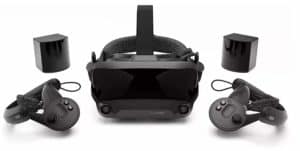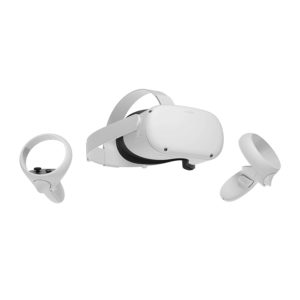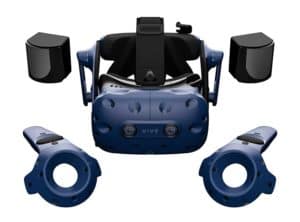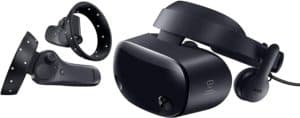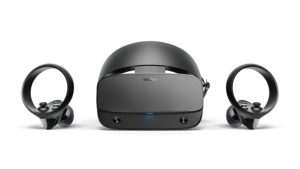Best VR Headset For VRChat in 2025
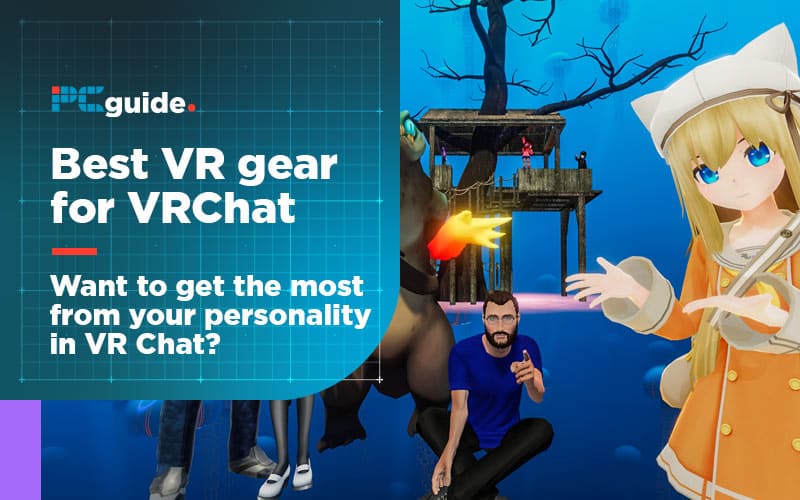
Table of Contents
If you’re looking for the best VR headset for VRChat, you’ve come to the right place!
From wild degen nights mentioned in hushed tones to wholesome interactions and simply watching some YouTube videos with like-minded people, VRChat is something every VR headset owner should sample at least once.
Modeled on the chat rooms ubiquitous in the early days of the internet, VRChat is a compelling and engaging virtual world designed specifically for socializing with people from all walks of life from across the globe. The VR aspect adds an element of immersion you’d be hard-pressed to find other than in the real world, ranking VRChat as a must-play for those in need of some respite from the forced solitude of the Covid hellscape we’ve all grown so accustomed to.
But, before you jump in, you’ll need the right headset for the job. Which is the best? How much should you spend? And, what’s different about each headset on the market? In today’s guide to the best VR headsets for VRChat, we’ll endeavor to answer those very questions to have you primed and ready to experience VRChat in all its virtual glory.
If you are looking to get into VR try these pages too:
Products at a Glance
How We Picked
Though VR still hasn’t fully hit the mainstream, there’s no shortage of headsets to choose from, which can be daunting for VR first-timers or even seasoned users eyeing up their next upgrade. The rapid pace of developments and more manufacturers jumping onto the bandwagon with their own headsets only complicates matters.
We’ve hand-picked five headsets from a selection of major manufacturers to help narrow down your choices to guaranteed winners. We’ve covered various price points from premium headsets that cost near enough the price of a gaming PC, all the way to more value-packed picks that are easier on the wallet.
Read on to find out the specifications and features of each and the additional information you’ll need to make an informed choice. With that said, here are our top picks for the best VR headsets for VRChat you can buy right now.
Product Reviews
- Best-in-class visuals and audio
- Premium materials and build quality
- 144 Hz refresh rate and 130-degree FOV
- Best controllers out there
- Price
- High-end PC requirement
- Setup
The Valve Index stands as the very best way to play VRChat: it’s a best-in-class headset among its commercially available peers that delivers a premium experience across the board from visuals and audio down to comfort and functionality. While the $1000 price tag raises questions about the value proposition on offer here, especially compared to headsets like the Oculus Quest 2, there’s no doubt the Valve is the headset of choice for the most immersive VR experience.
Much of what makes the Valve Index such a stand-out pick is the quality of the displays. The headset boasts ultra-sharp dual-canted full RGB lenses with a massive 130-degree field of view and the highest refresh rates among commercially available headsets, hitting a fantastically smooth 144 Hz alongside 80/90/120 Hz variable rates.
Thanks to all-around stellar construction, handpicked high-quality materials, and a broad selection of ergonomic adjustments, the Valve Index is highly comfortable when perched on the user’s head. Off-ear speakers do wonders for a dynamic, clear audio experience that does wonders to heighten sensory immersion.
The Valve Index’s Knuckle controllers are the best out there currently because of their per-finger tracking, intuitive button layout, high-fidelity, low latency natural-feeling responsiveness, balanced comfort, and generous battery life.
The price tag is naturally the biggest negative here, but it’s also worth noting that it requires an equally well-equipped gaming PC to get the very best out of the Valve Index (not least that 144 Hz refresh rate). You are also looking at a more elaborate setup than more plug-and-play headsets like the Oculus Quest 2.
- Affordable
- Dual mode - standalone and PC VR
- 90 Hz refresh rate and 90-degree FOV
- Easy setup
- Oculus Link cable required for the best VRChat experience
- Facebook login
Launched in October 2020, the Oculus Quest 2 is the new kid on the block, making waves ever since for offering VR users an affordably priced headset capable of both a standalone and typical PC VR experience. For us, it’s a great alternative to the Valve Index, not least because it costs half as much.
The Oculus Quest 2 boasts an LCD that delivers superb clarity and detail for the price thanks to a resolution of 3664 x 1920, a 90-degree field of view, and a refresh rate topping out at a 90 Hz for a smooth gaming experience. Throw in cinematic 3D positional sound, a lightweight design, an adjustable strap, and the easiest setup of pretty much any commercial headset thanks to in-built tracking, and the Oculus Quest 2 is as plug-and-play as it gets without sacrificing the VR experience nor comfort.
One of the major highlights is, of course, that the Oculus Quest 2 supports both untethered standalone play thanks to a Qualcomm Snapdragon XR2 chip and wired PC VR play on Steam and the Oculus Store via the Oculus Link USB-C cable, sold separately.
VRChat in standalone mode is viable, especially in terms of offering an untethered experience and the freedom of movements that entails. However, the visuals are watered down compared to PC VR, even from a reasonably modest gaming rig, as it’s none other than a mobile-optimized version of the game. We do recommend the PC VR version if at all possible for a complete VRChat experience.
A mandatory Facebook account and sign-in into the social media platform may not sit well with some. Still, it’s a palatable hoop to jump through for the most versatile and affordable headset currently available to buy.
- High-fidelity visuals and audio
- 90 Hz refresh rate and 110-degree field of view
- Comfortable to wear
- Immersive VR experience
- Expensive
- Not the best controllers out there
The vast difference in price between the Valve Index and Oculus Quest 2 leaves plenty of unclaimed ground for another contender to swoop in, such as the HTC VIVE Pro, a high-end premium headset that’s priced a little lower than the Index.
A pair of high-resolution AMOLED displays deliver a resolution of 2880 x 1600, 90 Hz refresh rate, and 110-degree field of view, positioning it just below the Valve Index in terms of specifications and color-rich, sharp visuals. It’s one of the most immersive headsets out there alongside the Index.
Other functional features such as integrated dual microphones, room-scale tracking up to 1000 square feet thanks to SteamVR Base Stations 2.0, and VIVE Wireless adapter prop up the HTC VIVE Pro further.
All-round comfort is a big plus for the HTC VIVE Pro thanks to its ergonomic design, ample padding, balanced weight distribution, and breadth of adjustment options, including the headband, interpupillary distance, and in-built 3D spatial audio headphones. The HTC VIVE Pro is more comfortable to wear than any headset out there other than the Valve Index.
The HTC VIVE Pro is slightly let down by a pair of mediocre controllers that, while perfectly usable, lack the functionality and tracking features of the Valve Index. Fortunately, the headset is fully compatible with the Index’s Knuckle controllers, should you want a more tactile experience than what’s offered as standard.
Although slightly cheaper than the Valve Index, the HTC VIVE Pro remains an expensive piece of kit and requires an equally expensive PC to tap into the best visuals it has to offer. Whether it’s more judicious to pay more for a Valve Index is certainly worth considering if you are already spending this much on a headset.
- 90 Hz refresh rate and 110-degree field of view
- Superb visuals
- In-built AKG-designed speakers
- Officially discontinued
- Expensive
Our top pick among Windows Mixed Reality headsets for VRChat is the Samsung HMD Odyssey+ for its fantastic visuals, easy setup, full SteamVR support, and built-in Bluetooth.
Powering the Samsung HMD Odyssey+ is an AMOLED display with anti-screen door effect technology pushing a resolution of 2880 x 1600, 110-degree field of view, and 60/90 Hz refresh rate. Visuals are crisp and sufficiently smooth to bring VRChat to life, free of any stuttering or performance issues as long as you have a decent PC to match.
Audio is also a strong point thanks to AKG-designed speakers that provide excellent sound to match the strong visuals on offer here. The Samsung HMD Odyssey+ is also comfortable to wear and comes with multiple adjustment options from IPD fine-tuning to the headband, though the weight distribution is a little front-heavy, which can cause pressure issues for some users.
Although Samsung HMD Odyssey+ hasn’t outright said as much, all signs point to the mobile giant abandoning the headset, limiting its involvement to support only. Alongside, the price tag of the Samsung HMD Odyssey+ is high even by VR standards for what it offers users. It’s the best WMR headset out there, but money is probably better spent on an Oculus Rift S or Quest 2 headset.
- Good balance between visuals, comfort, and price
- 80 Hz refresh rate and 110-degree FOV
- Won’t break the bank
- Discontinued
Although officially discontinued to make way for the new Oculus Quest 2, the Rift S is a value-packed option for playing VRChat, that is, if you can get your hands on one. Stock replenishment is few and far between as Facebook liquidates the last of its inventory, so finding one for sale can be a bit of a challenge, but if you do, chances are it will be competitively priced.
The Oculus Rift S features an LCD with a resolution of 2560 x 1600 capable of an 80 Hz refresh rate and 110-degree field of view, which positions it as a well-equipped mid-range headset, something that also extends to comfort thanks to a lightweight and durable design. Tracking is also exceptional, provided by highly accurate inside-out tracking for a reasonably straightforward PC VR setup, unlike headsets that depend on Base Stations for their tracking needs.
The visual immersion doesn’t measure up to the Valve Index or HTC VIVE Pro, but the Oculus Rift S costs half as much and certainly stands tall above more budget-oriented headsets out there. For those looking for the value of an almost premium headset at an attractive price, you can’t go wrong with the Oculus Rift S.
Things To Consider
Comfort and Adjustments
Due to the type of game, VRChat tends to involve long sessions with the headset. As such, it’s of utmost importance to buy a headset that has good comfort features: sufficient and well-placed padding, adjustable, well-made headbands that relieve pressure, a balanced weight profile across the head, and lightweight yet strong materials. The Valve Index and PlayStation VR are excellent examples of headsets where all these features are well-balanced. It’s no exaggeration to say that these headsets feel as comfortable after the first minute as a couple of hours into a play session.
Ideally, you’ll want to try out each headset before buying, but short of that, we’ve offered up our take on each of our picks’ comfort chops. Reddit and reviews from respected media outlets are also a good resource for a genuine gauge of what to expect.
Features To Look Out For
Resolution – Resolution refers to the pixel count a headset can produce. Higher resolutions result in a higher level of detail and clarity, which is important in VR given how close the user is to the image and how much this accentuates graphical issues such as pixelation and the like.
Refresh Rate – Refresh rate is linked to frame rates and essentially dictates how many images the headset can display in any given second. In VR, a high refresh rate is crucial as it ensures a stutter-free experience, and by extension, reduces the chance of motion sickness in the user.
Field of View – Field of view indicates how much of a virtual world is viewable in the VR headset at any given point. A large field of view means the experience feels more immersive as it edges closer to what the human eye sees naturally.
System Requirements
One major limiting factor in what headset you can potentially buy is system requirements. Much like your favorite games, VR headsets need a decent PC to get the most out of them. Therefore, it’s imperative that you check that your PC is up to the task before committing to a purchase. An under-powered PC will result in sub par, choppy and stuttery experience defined by low frame rates, an issue that’s all too often linked with instances of motion sickness.
These are differences depending on the model, but the general trend is that the more you pay for a headset (higher refresh rates and lower latency), the better PC you’ll need. For example, headsets such as the Valve Index require a quad-core CPU, NVIDIA GeForce GTX 1070, and 8 GB of RAM to deliver a decent VR experience.
As for VRChat, the basic requirements are an Intel i5-6500 / AMD Ryzen 5 1600 equivalent or greater, 8 GB of RAM, and NVIDIA GeForce GTX 1060/AMD Radeon RX 580 or better. These specifications represent the absolute minimum you’ll need to play and are a good starting baseline for your PC.
Our Verdict
The Valve Index is hands-down the best way to experience VR, including VRChat. It’s a best-in-class headset with all the trimmings and niceties, including stellar visuals, superb comfort, and the best controllers in the business by a considerable margin. If you can stomach the $1000 price tag, then the Valve Index is a sure-fire winner.
Considerably more affordable and thus attractive to the average VR user, the Oculus Quest 2 is a versatile headset with standalone and PC VR functions. It’s comfortable and suitably powerful to fuel those lengthy VRChat sessions. It’s only let down by mandatory Facebook sign-in.
Another high-end, high-fidelity headset that pushes the immersion levels in VRChat, the HTC VIVE Pro features robust specifications, sleek and stunning visuals, and a comfortable fit for the majority of users. Decent, if unimpressive controllers and a steep price tag are the only issues to weigh up.
Our top pick Windows Mixed Reality headset is the Samsung HMD Odyssey+ for its excellent visuals and audio, full SteamVR support, and ease of use. Finally, for those looking for a value-packed headset, the Oculus Rift S is an excellent pick with near-premium performance and features. It’s discontinued, though, so you may struggle to source one.
Our guide to the best VR headsets for VRChat now comes to an end. Don’t hesitate to drop any questions, concerns, or suggestions in the comments section just below.


